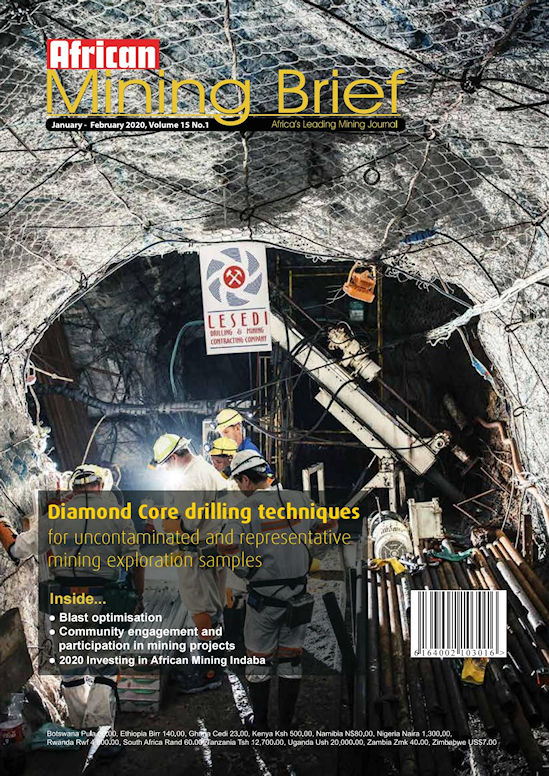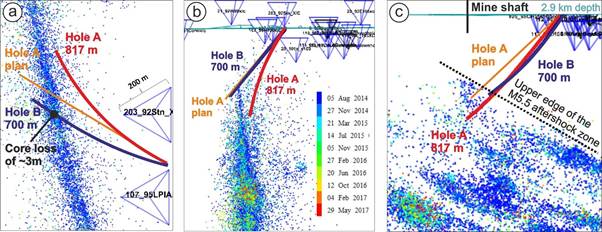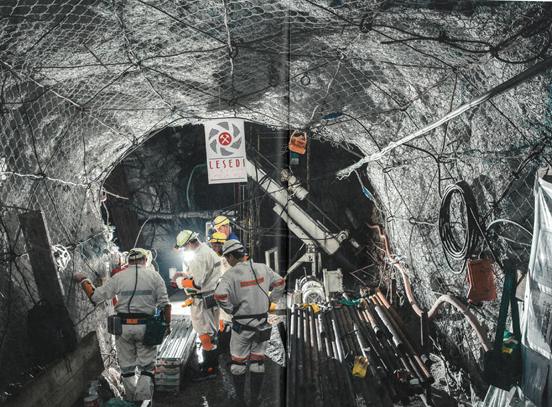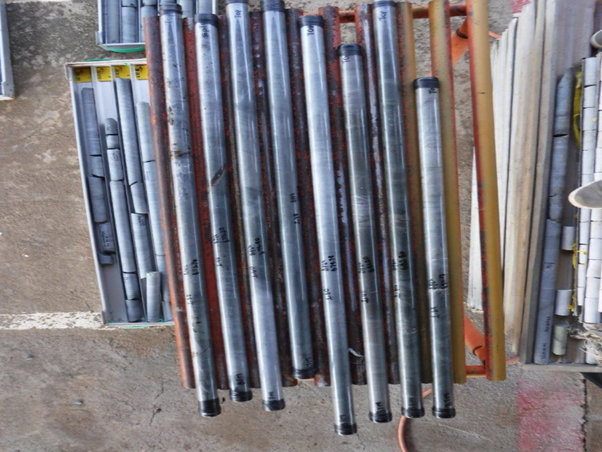
Diamond Core Drilling Techniques For Uncontaminated and Representative Mining Exploration Samples
In June 2017, Lesedi Drilling was appointed to drill a number of deep (1 000m) exploration holes from an underground site at Moab Khotsong Mine for an ICDP funded project known as DSeis. The project goal was to drill into defined seismogenic zones and to record the contents of water found in these zones in order for geomicrobioligists to better understand life forms that exist deep within this underground biosphere.
Background
Underground mine exploration drilling is a service provided by Lesedi Drilling to nearly all of the major South African mining houses. The bulk of the drilling is provided by small air machines drilling AXT size giving a 48mm hole and 32mm core size over an average hole length of 100 metres. Lesedi’s fleet of drills includes larger and more capable hydraulic drills which enable the drilling of larger core sizes over a longer distance. These drills have a power range from 22KW to 90KW and enable the drilling and recovery of core samples up to 1,5Km (“B” size) from the collar of the hole underground. Much of the drilling requires extreme care when intersecting the gold and platinum bearing reef horizons as the gold sample can easily be washed or ground away by bad drilling practise or by the lack of deployment of proper technology.
The International Continental Scientific Drilling Program ( ICDP) is an organisation made up of 22 member countries. The ICDP funds land based drilling projects for scientific purposes and is based at the German Research Centre for Geosciences in Potsdam Germany. South Africa is a member as is the United States, China, Japan and many scientific institutions in European countries.
Deep level mining in South Africa provides a rare opportunity to study earthquakes. Mining induces ground movements on a continuous basis and given the great depth of South African gold mines, the international scientific community is able to get access to these zones a lot more easily than would be the case if they had to be accessed from the surface of the earth. Furthermore, because of mining activities, the earthquakes are generally fresh zones and not old earthquake zones such as the San Andreas fault in California. This fact helps the scientific community understand the genesis of faulting, stress orientations pre and post seismic events, mineralization and microbiological activity around these seismic zones.
The August 5th 2014 earthquake at Orkney in South Africa (M 5,5 magnitude earthquake) occurred at depths of between 3,5km and 7 km below the surface. The event provided an excellent opportunity to study the causes and effects of a large seismic event. The quake occurred below deep level operations at AngloGold Ashanti’s Moab Khotsong Mine. AngloGold had already installed an extensive network of surface and underground seismometers, geophones and strain gauges and this enabled the scientists to determine the source of the seismic event which was estimated to be 1 km below current mining operations on 95 level at Moab which were already at a depth of 2,9 Km below surface.
Professor Hiroshi Ogasawara of Ritsumeikan University in Japan, who has had a long association with the South African geosciences research organisations and large mining houses, led an international team to formulate a project plan to drill into this new and unusual seismic zone. The DSeis project (Drilling into Seismic Zone) was presented to the ICDP and it was accepted and funding provided in 2016. The project objectives were to:
- Probe the highly unusual strike-slip fault in the seismic zone which had caused the 2014 Orkney earthquake – the biggest from a mining induced event in recent times.
- Determine what physical properties control ground rupture evolution and termination by drilling into the rupture area and zones outside of and on the edges of the rupture.
- Understand how fluid and chemical properties of faulting influence the microbiological communities in this deep biosphere.
DSeis Diamond Drilling requirements.
In order to achieve their objectives, the DSeis project specifications required that:
- A number of holes were to be drilled from a site on 95 level at Moab Khotsong mine and the drill rig needed to be capable of drilling NQ size to a depth of 1 000m from an underground site no larger than 6m X 6m X 6 m.
- In the seismogenic zones which are in a critical state of stress, it is necessary to determine the direction and magnitudes of the principal stresses. Accurate core orientation was an absolute requirement.
- As close as possible to 100% core recovery was essential in order to determine critical and minute changes in the mineralogy surrounding the seismic zones. Hydrothermal waters and gases contained in the rock sample also needed analysis and would be highly susceptible to contamination from drilling muds, greases and surface water. It was an absolute requirement that contamination of the core be eliminated as a possibility.
- Directional drilling was required to ensure a number of samples could be taken in the seismic zone.
- Triple tube drilling was required in the seismic zone and the core sample needed to be completely isolated from an contaminants as described in paragraph 3.
- Should deep hydrothermal waters flow into the hole it is necessary to determine the water quality, age, microbiological life and gas content of the water. Packers are required to be set in order to isolate this inflow from drilling water and chemicals used in drilling.
- Smaller air driven drills also drilling triple tube are needed to drill into seismic zones (+-M 2,2) which are much closer to the mining operations. (50m)
- Hole deviation should be minimized and frequent surveys are required to ensure the hole remains on target
The Drilling Operations
The target zones
The three figures below show the traces of the holes drilled into the seismogenic zone. (Coloured dots showing seismic events 2014-2917)

Lesedi Drilling site on 95 level Moab Khotsong

Meeting DSeis requirements
The Drill
Lesedi Drilling deployed one of its nine LM 90 deep hole hydraulic core drills to the DSeis project at Moab Khotsong 95 level. The 90 KW hydraulic drilling machine is capable of drilling NQ size to 1 000m depth from a relatively small excavation underground and is ideal for a project of this nature. Constant surveying for directional control and accurate core orientation for rock stress measurements was provided by Boart Longyear’s TruCore system. These inhole operations and geophysical acoustic and optical logging means frequent pulling and lowering of in hole tools and the LM 90 powerful wireline winch is designed for this hard work. The LM 90 machine is particularly quick and efficient at rod handling ensuring high levels of productivity out of a very confined space (figure 1). Rod stabilizers, the correct muds to enable free cutting of the diamond bit and slow drilling not in excess of 15m per shift were used to reduce deviation in the hole.
The first hole (A) was drilled to a depth of 817m. The hole ran sub parallel to the aftershock zone for several hundred metres. The hole intersected water at about 450m and after drilling was concluded, the hole was sealed by packers at this depth in order to monitor the water. The water was found to be ancient water around 1,5bn years old in age, hyper saline (about 7 times more saline than the ocean), had a temperature of 60 degrees Celsius and contained microbes which are unique to life that survives by metabolising hydrogen and carbon originating from the rock deep within the earth.
Hole B and C
The collar of this hole was adjacent to hole A but the drill rig was reoriented by 15 degrees in order to intersect the seismic zone. The geology of this hole mirrored that of Hole A until the hole intersected an intrusive rock followed by a void and an inrush of methane. The void resulted in a loss of 3m of core but at about 700m the hole returned to the competent quartzites of the Babrosco formation. The void in the seismic zone posed a risk to the expensive rod string and logging tools and it was decided to insert a directional wedge at 545m below the collar and redrill a third hole - hole C- into the seismic region.
The wedge would give a separation of about 10m from the original hole which intersected the void and methane. Triple tube core barrels (1,5m length) were used on this very important drilling. Usually split tubes are used to contain the core in a triple tube system but due to the need to eliminate contamination all together, sealable clear PVC tubes were used instead. When the corebarrel arrived at the collar the PVC tubes were immediately sealed taken to surface and sent to Johannesburg where they were scanned with a DMT 360 degree optical scanner by a team from the University of the Witwatersrand. The hole traversed the seismic zone and was stopped in the Babrosco quartzites. The core was found to contain the mineralization associated with earthquake activity but much younger in that it was only a few hundred years old.
Extensive scientific interpretation of the core samples continues and more drilling is expected to commence next year.
Summary
By using a clear PVC tube in the triple tube corebarrel system, it was possible to get high quality uncontaminated core samples suitable for the analysis of stress and its orientation, mineralogy and microbiological life some 3,5km below the earths surface.

PVC barrels from the NQ triple tube corebarrel containing uncontaminated core for analysis (figure 2)
References and thanks
- Professor Ogasawara from Ritsumeikan University
- AngloGold, Sibanye and Harmony Gold Mines
- DSeis and ICDP Project teams
Interested readers may wish to read further on the topic of this research. The best links are:
Http://dseis.icdp-online.org
Http://orkney.icdp-online.org
Contact
Hiroshi Ogasawara
Ritsumeikan University, College Of Science And Engineering, Department Of Physical Sciences
Yasuo Yabe
Tohoku University, Research Center For Prediction Of Earthquakes And Volcanic Eruptions
Takatoshi Ito
Tohoku University, Institute Of Fluid Science
Gerrie Van Aswegen
Institute Of Mine Seismology
Artur Cichowicz
Polish Academy Of Sciences, Institute Of Geophysics
Raymond John Durrheim
University Of The Witwatersrand, School Of Geosciences
Tullis C. Onstott
Princeton University, Department Of Geosciences
Thomas L. Kieft
New Mexico Institute Of Mining And Technology, Department Of Biology
Margaret S. Boettcher
University Of New Hampshire, Center For Coastal And Ocean Mapping/ Joint Hydrographic Center
Stefan Wiemer
Swiss Federal Institute Of Technology Zurich, Department Of Earth Sciences, Institute Of Geophysics, Swiss Seismological Service
Martin Ziegler
Swiss Federal Institute Of Technology Zurich, Department Of Earth Sciences, Engineering Geology
Serge A. Shapiro
Free University Of Berlin, Department Of Earth Sciences, Institute Of Geology, Geophysics And Geoinformatics, Seismics Working Group
Harsh Gupta
Council For Scientific And Industrial Research, National Geophysical Research Institute, Department Of Seismology
Phillip Dight
University Of Western Australia, Australian Centre For Geomechanics